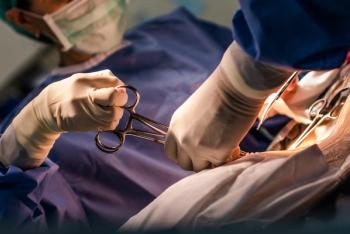
Did delay in bladder repair cause urologic issues?
Allegations in this complex case include negligence in performing laparoscopic hysterectomy and delaying treatment of bladder injury.
Facts
The 46-year-old plaintiff first presented to her primary care physician (PCP) on April 23, 2013, for a cough that had lasted 3 days. She reported incontinence, dribbling, and an inability to hold her urine after heavy menstruation. She also reported abdominal pain. Her PCP urged her to go to an ob/gyn for a work-up, with the differential possibly being endometriosis versus ruptured cyst. The impression was that the patient had recurrent stress urinary incontinence but the ob/gyn was concerned that it could turn into physical incontinence, given the woman’s gynecologic issues and age. The plan was to send her for an ultrasound (U/S) of the pelvis, which was performed on May 1, 2013. The U/S revealed a very large uterine fibroid (7x7 cm).
On May 5, 2013, the plaintiff presented to nonparty hospital with complaints of lower abdominal pain and vaginal bleeding that had lasted for 2 days. She reported bright red blood with multiple clots that increased throughout the day and her diagnosis with a 7x7-cm uterine fibroid by her PCP but said she did not have an ob/gyn. On exam, she reported that she had a history of heavy menses secondary to the fibroid. Transvaginal (TVUS) confirmed multiple fibroids, the largest being 8.7 cm, and an enlarged uterus (8.5 x 12.2 cm). The impression was leiomyoma of the uterus. The woman was sent home in stable condition that night because she felt better, with a directive to follow up with an ob/gyn that week.
The plaintiff saw her PCP on July 23, 2013, for the start of preoperative medical clearance for a hysterectomy.She was cleared for surgery. Importantly, she reported incontinence and dribbling and that she could not hold her urine after menstruating. The assessment was vaginal bleeding, with abdominal pain secondary to the abdominal fibroids.
On or about August 26, 2013, the plaintiff presented to Defendant Hospital A for a laparoscopic hysterectomy by Defendant ob/gyn A, secondary to bleeding fibroids. The plaintiff’s history included a cesarean delivery, open cholecystectomy, bilateral breast reduction, and treatment for a miscarriage. During the hysterectomy, she sustained a bladder injury. An intraoperative cystoscopy confirmed a 2-cm tear near the vaginal cuff. Two double-J ureteral stents were placed by Defendant urologist, who recommended that she be transferred to Defendant Hospital B. The woman’s bladder was not repaired intraoperatively; instead she was transferred after Defendant ob/gyn A spoke with Defendant ob/gyn B.
On August 27 at 11:40 p.m., the plaintiff was transferred from Defendant Hospital A to Defendant Hospital B with an admitting diagnosis of injury to the bladder and urethra and open wound. The admitting physician was Defendant ob/gyn B, who attempted conservative management; for 48 hours, the patient was stable without any issues. On August 29, a decision was made to perform a cystoscopy to further evaluate the bladder injury. Defendant ob/gyn B’s operative report indicated that informed consent was obtained. A cystogram was performed using 200 mL of fluid without obvious contrast extravasation. The plaintiff’s Foley catheter was removed and the two previously placed double-J stents were identified and noted to be in good position. A cystoscopy then was performed, and at the level of the trigone in the posterior portion of the bladder, an area consistent with the intraoperative injury was found. The same was noted to have granulating tissue but no obvious tear or extraperitoneal leak was seen. As a consequence, Defendant ob/gyn B decided “to not proceed with a formal repair” and instead, decided to continue to conservatively manage the plaintiff. The Foley catheter was replaced and the report concluded with a comment that the patient was to follow up in the office within the next 2 weeks for a repeat cystoscopy and removal of the double-J stents that had been placed. In the Postoperative Acute Care Unit, she received 2 units of blood. Discharge was on August 30.
Facts (cont'd)
A day later, the plaintiff was readmitted to Defendant Hospital B complaining of no urine output from the Foley catheter for 12 hours, lower abdominal pain, and difficulty breathing. The catheter was changed in the ER without relief of symptoms, so the plaintiff was admitted. On U/S, her bladder was small with fluid around it. A computed tomography (CT) scan showed that the Foley catheter was out of the bladder and in the peritoneum. The catheter was repositioned and conservative management was attempted. However, the patient had desaturations in oxygen to the 80s and was found to have bilateral pulmonary embolisms (PEs). Dopplers came back negative for deep vein thrombosis. Because of the woman’s history of PEs, a removable inferior vena cava filter was placed by vascular surgery. An intravenous (IV) heparin drip also was started. The plan was to stabilize the patient medically and then take her to the operating room (OR) for an open bladder repair.
On September 3, repair surgery was undertaken by Defendant ob/gyn B. The procedure was described as an open complex cystorrhaphy with a repair of bladder injury and placement of a suprapubic tube. Per the OR report, “due to the location of the injury at the level of the trigone, a decision was made to perform an intravesical repair.” As a result, a cystotomy was performed in the dome of the bladder. The injury was noted to be at the trigone between both ureteral orifices. A suprapubic catheter was placed and the plan was to monitor the patient, transition her back to a heparin drip and eventually warfarin, with the hopes of discharging her a few days thereafter. Postoperatively, the plaintiff had bouts of tachycardia. She remained on a heparin drip. Transthoracic echocardiography showed evidence of some right heart strain. Heparin was changed to enoxaparin sodium. The suprapubic tube eventually drained clear urine and the patient was discharged on September 6 with the suprapubic tube to the Foley catheter and a three-way, 24-French Foley to leg bag.
On September 13, the plaintiff followed up with Defendant ob/gyn B at his office. On exam, the doctor found her to be doing well with a suprapubic tube and the Foley catheter in place. He planned to keep the catheters in for the next 2 weeks and the note indicated she would be following up with her PCP regarding management of her warfarin level. Defendant ob/gyn B planned to perform a cystogram at the next visit and perhaps remove the Foley catheter but he intended to leave the suprapubic tube in for another few weeks. The plaintiff went to her PCP on September 24 for complaints of a urinary tract infection (UTI) with abrupt onset. Her symptoms concluded voiding scant amounts while urinating and the last occurrence was a few weeks before, and burning pain. Diagnosis was acute cystitis, UTI and she was started on sulfamethoxazole/trimethoprim.
A note written by Defendant ob/gyn B about the patienht’s return visit on September 27, repeated the history and said that the patient is “doing well with no complaints other than minimal pain from the Foley.” A cystogram was performed and no evidence of extravasation was noted. The Foley catheter was removed but the suprapubic tube was left in place. When plaintiff returned to Defendant ob/gyn B’s office a week later, a cystogram showed no evidence of extravasation and the suprapubic tube was removed. The bilateral stents were left in place and the patient was directed to return in
3 weeks for their removal. In addition, she was placed on more antibiotics as a result of a complaint of dysuria.
On October 8, the plaintiff was seen by her PCP for a complaint of 4-day lumbar radicular syndrome, pain 4/10. She also reported frequent urination, incontinence, dribbling, and painful urination. She reported that the pain started after the catheter was removed. The plan was that she return to the urologist for catheter placement versus further evaluation. On October 10, the plaintiff was transferred to Defendant Hospital B with complaints of nausea, vomiting, and flank pain and a diagnosis of pyelonephritis. A Foley catheter was placed and she was started on IV antibiotics. A CT scan showed bilateral moderate hydronephrosis with left perinephric stranding.
Facts (cont'd)
On October 12, Defendant ob/gyn B brought the patient back to the OR for a cystoscopy, during which he removed the bilateral stents. A cystogram was performed and again no contrast extravasation was seen. Thereafter, a cystoscopy was performed. The report noted that the “entire mucosa was extensively observed” and in the area of the previous repair, debris and granulation tissue were noted. Both ureteral orifices were easily identified, and both the right and left ureteral stents were noted to be calcified with debris. It was felt that the stents might be a possible source for the UTI, so they were removed. The plan was to monitor the plaintiff over the next 12 hours to see if there was any improvement. The Foley catheter was removed and she passed a trial of void so she was discharged on October 13. An appointment with Defendant ob/gyn B was made for October 25 but then rescheduled to November 22. At that visit, the plaintiff was 1 month post-removal of the stents, appeared to be doing well save for the complaint of increasing nocturia every 1 1/2 to 2 hours during the evenings as well as frequency throughout the day. Defendant ob/gyn B performed a physical exam and found nothing out of the ordinary except for some costovertebral angle tenderness. Under “Impression” he called the plaintiff a woman with “significant lower urinary tract symptoms” and indicated that while a urine dipstick showed some white blood cells, there was no obvious UTI. A culture was sent and the patient was placed on solifenacin to see if this would improve her nocturia. She was directed to return in 4 weeks for a repeat uroflow and postvoid residual (PVR) but she did not.
On August 21, 2014, the plaintiff saw her PCP with complaints of frequent urination as well as vaginal bleeding between periods or after sex. She also reported that this began after surgery. She reported being treated with solifenacin with good results. She was given another prescription for the drug, 10 mg daily. The plaintiff returned to Defendant ob/gyn B on September 3 (10 months after her last visit) for the final time. The purpose of the visit was for a new onset of urinary incontinence. In his note, Defendant ob/gyn B recited the woman’s history of the complex bladder injury and repair, the pulmonary embolus. He also mentioned her “bleeding issues” (hypercoagulability), for which she was under the care of a hematologist. The plaintiff reported that she had been feeling well over the preceding 6 months and it was only 2 weeks prior when she started to notice the urinary incontinence. She denied any other urinary issues but did report that she was having some pelvic pain. A urine dipstick done in the office was within normal limits and the patient was scheduled for further evaluation with flexible cystoscopy. She did not return.
On October 30, the woman saw her PCP with complaints of bladder discomfort and UTI symptoms. She did not feel her complaints were socially unacceptable, but had leaking when she laughed, sneezed, and coughed. She also reported urinary frequency but no pain with incontinence. The diagnosis was UTI, acute cystitis. The plan was to start antibiotics.
The plaintiff went back to her PCP on February 27, 2016. His note reported that she presented for urinary incontinence and indicated that the woman was status-post multiple bladder procedures with new incontinence. The plan was to reorder medication for incontinence and that she should follow up with urology and urological studies. On July 18, the woman was seen by her primary care physician for lesions found on her rib cage via a CT chest. She had no complaints of dysuria, frequency, urgency, nocturia, hematuria or incontinence. Her exam was normal. The PCP referred the plaintiff for a bone scan to rule out metastatic disease, which was performed on July 28. On July 29, The PCP notified the woman that the results were normal.
Allegations
The plaintiff argued that the defendants delayed diagnosing a fibroid uterus, menorrhagia, and anemia and delayed treating fibroids and performing a hysterectomy. The plaintiff’s side further alleged that the defendants negligently performed a laparoscopic hysterectomy, delayed timely treatment of complex bladder injury, failed to diagnose said injury intraoperatively, failed to diagnose and treat or prevent bladder damage, delayed surgery, failed to have appropriate surgical specialists available, failed to assess risk factors for a PE, caused a PE, and failed to properly place a Foley catheter.
They contended that the bladder injury was diagnosed by defendants just after the hysterectomy was completed and during the cystoscopy of August 29, 2013. They argued that good and accepted medical practice required immediate repair of the hole in the plaintiff’s bladder. They contended that the delay placed the plaintiff at risk for further complications including the worsening of her condition, worsening of the hole, reopening of the hole, incomplete closure, additional procedures, infection, increased risk of urinary incontinence and/or frequency and pain.
Discovery
Our firm only represented ob/gyn B in this matter.
Our urology expert was able to defend Defendant ob/gyn B. The plaintiff’s injury, the cystotomy, occurred during the hysterectomy on August 26, 2013. He confirmed that any delay in performing surgery to repair the cystotomy did not cause further injury to the woman. Moreover, incontinence-her alleged injury-pre-existed the surgery. Therefore, any complaint that she was now at an increased risk because she was treated conservatively made no medical sense. In fact, she would be at an increased risk if she had surgery. Furthermore the repair itself was undertaken in a standard fashion and expertly performed.
The gynecology expert advised that the approximate 2-day delay in repairing the patient’s bladder injury made no difference. On August 29, Defendant ob/gyn B performed a cystogram and a cystoscopy to assess the extent of the plaintiff’s injury. The cystogram showed no evidence of leakage and the cystoscopy confirmed the finding. While some healing tissue was found, no perforation was found and there was no extravasation of dye. Defendant ob/gyn B directly visualized the area, and it appeared to be healing. Given the complexity of the repair that would have been necessary due to the injury’s location, Defendant ob/gyn B decided to treat the plaintiff conservatively. Our expert opined that the prudent course was to let her continue to heal as she appeared to be healing on her own, and not subject her to a further complicated surgery. As a general matter, although there is variation from patient to patient, but if a patient does not have a leak and is healing, treatment is conservative. Waiting for evidence of a leak for 2 days did not cause or contribute to subsequent urinary issues.
At Defendant ob/gyn B’s deposition, it became evident that the plaintiff really had no claims against him and was hoping, by naming him as a defendant and taking his deposition, that he would implicate the co-defendants. To the extent that the plaintiff found it necessary to have him testify that the injury to the bladder occurred at the prior institution, he accomplished his purpose. To the extent he had hoped that ob/gyn B would offer comment that the injury to the bladder was caused by negligence, he was unsuccessful. In fact, he testified that he had no knowledge of how the injury occurred other than learning that it happened during the surgery undertaken at the codefendant Hospital.
ResultThe case settled as to co-defendant ob/gyn A prior to trial. Ob/gyn B was given a voluntary discontinuance.
AnalysisThis case was interesting because we essentially knew from the time of our client’s deposition forward that the plaintiff was not focusing on his actions or inactions and that so long as we maintained our defense posture, we were likely to extract him from the case if and when our codefendant settled. We were certainly prepared to defend his care at trial if it came to that. Sometimes things work out that way, but it is imperative to have the case fully worked up and evaluated to ensure you are in your best position to defend whatever allegations–credible or otherwise–are advanced. Ob/gyn B was prepared to not only defend his care but also not to offer opposing counsel any testimony that could implicate his codefendants and further the plaintiff’s somewhat specious claims.
Newsletter
Get the latest clinical updates, case studies, and expert commentary in obstetric and gynecologic care. Sign up now to stay informed.











